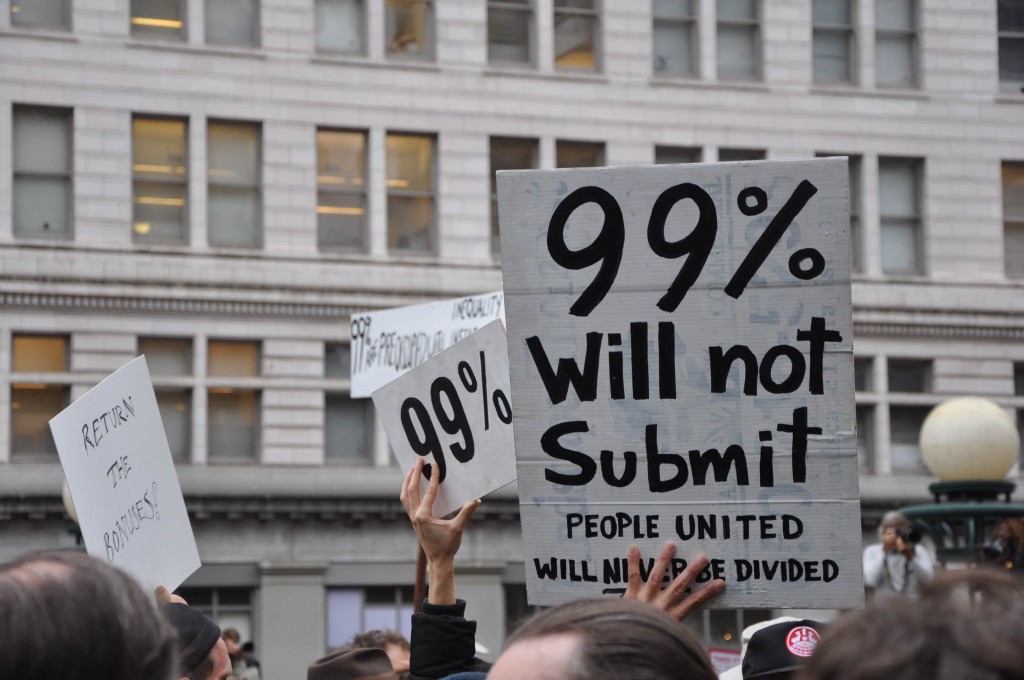Over 1000 people gathered yesterday in Frank Ogawa Plaza in Downtown Oakland — 4PM marked the kickoff of Oakland’s participation in the nationwide “Occupy Wall Street” movement.

The Oakland protest, “Occupy Oakland,” takes as a starting point the same basic principles of the larger struggle of the Occupy Wall Street movement, which began almost a month ago on September 17 as people camped out in the financial district of New York City to “restore democracy to America” (occupywallst.org). Although yesterday’s protest was an offshoot of this larger movement — relying on many of the same demands, such as a resounding call for wealth redistribution basic rights and healthcare for everyone — it also had a distinctive, Oakland character.
 Among the vast crowd of protesters were the faces of many Mills students, both past and present.
Among the vast crowd of protesters were the faces of many Mills students, both past and present.
“I came out today because I’ve been following the movement,” said Mejin Leechor, an MPP program alum who graduated in Spring of 2011. “One thing I’ve been paying attention to is people who are trying to raise consciousness and have the movement include people of color, not just have it be a pretty white male movement.”
Several intra-groups have been formed to ensure the inclusion of more people of color in the movement, such as Occupy the Hood and People of Color Working Group. The tumblr site, pococcupywallstreet.tumblr.com, highlights problems which arise from not taking into consideration POC perspectives: “Let’s be real. The economic crisis did not begin with the collapse of the Lehman Brothers in 2008. Indeed, people of color and poor people have been in a state of crisis since the founding of this country, and for indigenous communities, since before the founding of the nation. We have long known that capitalism serves only the interests of a tiny, mostly white, minority.”
 Speakers at the event recognized that the kickoff was in conjunction with Indigenous Resistance Day, a holiday which many throughout the nation now observe in place of Columbus Day. From the first hour, speakers acknowledged that Ogawa plaza itself was already on occupied Ohlone land, and later in the evening a member of the Ohlone tribe came to speak to the protesters.
Speakers at the event recognized that the kickoff was in conjunction with Indigenous Resistance Day, a holiday which many throughout the nation now observe in place of Columbus Day. From the first hour, speakers acknowledged that Ogawa plaza itself was already on occupied Ohlone land, and later in the evening a member of the Ohlone tribe came to speak to the protesters.
The United States (and, increasingly, places outside the country) has few spots left on it that have not been touched by — or, as in the case of Oakland and many other major cities, had their own full-blown version — of the Occupy Wall Street movement.
The protest commenced with a phone call to the New York City organizers, which was held up to a microphone to try to include everyone present in the conversation. The voice on the other end of the phone declared, “The only thing that can tear the system down is us, working together,” which was met with many cheers from those present.
“It’s about time for this — and it’s amazing that this many people have come out across the country,” said Sonya Rifkin, class of ’10. “It’s powerful to participate in something such a diverse group of people are calling for.”
Organizers called everyone to the steps in front of city hall for a general assembly, where they encouraged protesters to break out into groups to talk to each other about why they had come and what was important to them.
“I came because I want to see what’s going to happen,” said Jennifer Federico, an Oakland resident who works at an environmental non-profit. “I’m ready to participate if there’s something concrete,” she said.
A reoccurring critique of the protests both from inside and out has been that their demands are too abstract or not specific enough.
In response to this, the website OccupyOakland.org reads, “This occupation is a beginning, and we have a long way to go. And while we have much in common, we believe the people are stronger united behind many banners, rather than a single one. We want to make it very clear that Occupy Oakland is not putting forward leaders, tactical or strategic directives, or a uniform message or political platform.”
The demands and impetus of the movement are documented by individuals through the Tumblr site WeAreThe99Percent.tumblr.com, which features hundreds of pages of posts uploaded by Americans and people around the world holding their stories of struggling to get by or overcome debt ended with the claim, “WE ARE THE 99%.” The 99 percent slogan refers to about 50 percent of the nation’s wealth being held by a one percent minority (statistics courtesy of multinationmonitor.org).
The Occupy protests have been likened to an “American Spring,” by organizers and many media platforms — and certainly the widespread populist nature of the movement has encouraged many people to get involved.
“I didn’t know about this ‘American Spring’ stuff, but now that I can be here physically and see people standing their ground and calling out financial institutions, I believe it,” said Jessica Langlois, a ’10 Mills grad program alumna.
The Facebook event for Occupy Oakland marks the end as Friday, February 12th 2012, but it is unclear how long the camp-outs will continue — as of now, there are still tents pitched in Ogawa Plaza. A community has formed, complete with urban medics, food donations, a freeschool, and the opportunity for individuals to perform or speak to the protesters.
“This is our generation’s final stand to find out who we are,” said Michelle Tassin, a first year at Mills. “It’s really important to participate and be active.”

